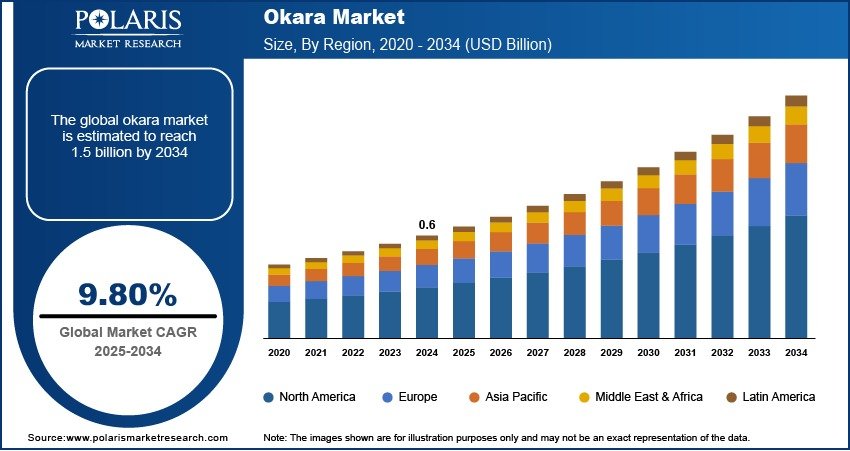Okara Market Size is projected to reach USD 1.5 billion by 2034, growing at a CAGR of 9.80%.

Key Market Trends & Insights For The Okara Market
-
Rising Demand for Plant-Based Protein
-
Okara is gaining popularity as a high-fiber, high-protein meat and dairy alternative.
-
-
Expansion in Functional Food Products
-
Used in snacks, baked goods, and nutrition bars due to its health benefits.
-
-
Waste-to-Value Trend
-
Food manufacturers are upcycling okara (soy pulp byproduct) to reduce food waste.
-
-
Growing Vegan and Vegetarian Consumer Base
-
Okara appeals to the growing number of health-conscious and ethical consumers.
-
-
Use in Animal Feed and Pet Food
-
Okara is increasingly used in sustainable livestock and pet nutrition.
-
-
R&D in Powdered and Shelf-Stable Forms
-
Focus on improving shelf life and usability in packaged food applications.
-
Market Size & Forecast
Market size value in 2025 – USD 0.7 billion
Revenue forecast in 2034 – USD 1.5 billion
CAGR – 9.80% from 2025 – 2034
Request for Free Sample:
https://www.polarismarketresearch.com/industry-analysis/okara-market/request-for-sample
Market Overview:
Okara, also known as soy pulp, is a nutrient-rich by-product obtained during the production of soy milk and tofu. Composed primarily of insoluble fiber, protein, and isoflavones, okara has gained attention for its potential applications in food, animal feed, pharmaceuticals, and cosmetics. Traditionally underutilized and often discarded or used for livestock feed, increasing awareness of sustainability and circular economy principles has led to growing interest in repurposing okara into value-added products. As industries seek eco-friendly and functional ingredients, the okara market is gradually expanding across both food and non-food sectors.
Key Market Growth Drivers:
A major driver of the okara market is the rising demand for plant-based, sustainable ingredients in the food industry, particularly among health-conscious consumers seeking high-fiber and protein-rich diets. The global shift toward reducing food waste and utilizing by-products from food processing has further boosted investment in okara-based product development. Additionally, growth in the plant-based dairy and meat alternatives market provides new opportunities for okara as a natural texturizer and nutritional enhancer. Research into the functional benefits of okara, such as its prebiotic properties and cholesterol-lowering effects, is also encouraging its incorporation into functional foods and nutraceuticals.
Market Challenges:
Despite its potential, the okara market faces several challenges, including its perishability, strong beany flavor, and coarse texture, which can limit its application in food formulations without additional processing. Lack of standardized processing and preservation techniques hampers large-scale commercialization and consistency in product quality. Consumer awareness and acceptance of okara-based products remain low in many regions, posing marketing and educational barriers. Moreover, the cost associated with drying, refining, and flavor-masking technologies can affect profitability, making it essential for manufacturers to invest in innovation and cost-effective processing solutions.






![Gabapentin Market Analysis: Opportunities, Innovations, and Growth Potential Through [2025-2034]](https://beeswire.com/wp-content/uploads/2025/07/polaris-59-768x768.png)